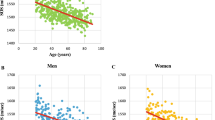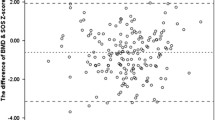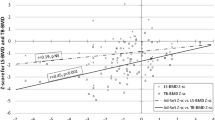Abstract
The assessment of bone quality by quantitative ultrasound (QUS), a transportable and relatively cheap method, shows some correlations with bone mineral density (BMD) as measured by dual-energy X-ray absorptiometry (DXA) and with fracture risk. To examine its correlation with bone metabolism in a population of institutionalized elderly people known to be at high risk for vitamin D deficiency and secondary hyperparathyroidism, QUS of the calcaneus and biochemical parameters were measured in 264 women aged 85±7 (SD) years and in 103 men aged 81±8 years living in 19 nursing homes. Vitamin D deficiency was frequent in this population: 41.9% of the women and 31.4% of the men had a serum 25-hydroxyvitamin (25OHD) level below the 2.5th percentile level of 3276 normal Swiss adults (6.2 µg/l or 15.5 mmol/l). Hyperparathyroidism was less frequent: serum parathyroid hormone (PTH) levels were above the 97.5th percentile level of normal adults (70 pg/l) in 18.9% of women and 9.8% of men. In women, QUS data correlated significantly with age (r=−0.297), body mass index (BMI) (r=0.403), calcium (r=0.220), PTH (r=−0.296), 25OHD (r=0.298) and alkaline phosphatase (AP) (r=−0.170) for broadband ultrasound attenuation (BUA), and with age (r=−0.195), BMI (r=0.208), PTH (r=−0.174), 25OHD (r=0.140) and AP (r=−0.130) for speed of sound (SOS). In men, ultrasound data correlated with BMI (r=0.326), calcium (r=0.199), 25OHD (r=0.258) and AP (r=−0.311) for BUA, and with AP (r=−0.196) for SOS. In women, but not in men because of their smaller number, a multivariate analysis was performed to examine relationships between age, BMI, biochemical markers and QUS. Age, BMI, PTH and phosphate explained 30% of the variance of BUA and 10% for SOS. In conclusion, QUS of bone evaluates characteristics of bone that are influenced, at least partially, by age, BMI and the secondary hyperparathyroidism due to vitamin D deficiency.
Similar content being viewed by others
References
Corless D, Gupta SP, Sattar DA, Switala S, Boucher BJ. Vitamin D status of residents of an old people’s home and long-stay patients. Gerontology 1979;25:350–5.
Chapuy MC, Chapuy P, Meunier PJ. Calcium and vitamin D supplements: effects on calcium metabolism in elderly people. Am J Clin Nutr 1987;46:324–8.
Lips P, Wiersinga A, Van Ginkel FC, Jongen MJM, Netelenbos JC, Hackeng WHL, et al. The effect of vitamin D supplementation on vitamin D status and parathyroid function in elderly subjects. J Clin Endocrinol Metab 1988;67:644–50.
Heikinheimo RJ, Inkovaara JA, Harju EJ, Haavisto MV, Kaarela RH, Kataja JM, et al. Annual injection of vitamin D and fractures of aged bones. Calcif Tissue Int 1992;51:105–10.
Deroisy R, Zheng XS, Pirenne H, Frederick I, Collette J, Reginster JY. 25-Hydroxyvitamin D deficiencies and secondary hyperparathyroidism in elderly women living at home or in nursing/retirement homes. Osteoporos Int 1996;6(Suppl 1):119.
Burckhardt P, Gerber S, Jacquet AF, Thiébaud D. Lack of fish is the main cause of vitamin D deficiency in institutionalized elderly swiss subjects. J Bone Miner Res 1993;8(Suppl 1):S218.
Recommended Dietary Allowances. 9th ed. Food and Nutrition Board, Nutritional Research Council. Washington, DC: National Academy of Sciences, 1980.
Chapuy MC, Arlot ME, Duboeuf F, Brun J, Crouzet B, Arnaud S, et al. Vitamin D3 and calcium to prevent hip fractures in elderly women. N Engl J Med 1992;327:1637–42.
Lees B, Stevenson JC. Preliminary evaluation of a new ultrasound bone densitometer. Calcif Tissue Int 1993;53:149–52.
Yamasaki K, Kushida K, Ohmura A, Sano M, Inoue T. Ultrasound bone densitometry of the os calcis in Japanese women. Osteoporos Int 1994;4:220–5.
Schott AM, Weill-Engerer S, Hans D, Duboeuf F, Delmas PD, Meunier PJ. Ultrasound discriminates patients with hip fracture equally well as dual energy X-ray absorptiometry and independently of bone mineral density. J Bone Miner Res 1995;10:243–9.
Krieg MA, Thiébaud D, Landry M, Burckhardt P. Evaluation de la qualité osseuse par ultrason quantitatif. Schweiz Med Wochenschr 1996;126:159–63.
Bauer DC, Glüer CC, Pressman AR, Vogt TM, Ensrud KE, Cauley JA, et al. Broadband ultrasonic attenuation (BUA) and the risk of fracture: a prospective study. J Bone Miner Res 1995;10(Suppl 1):S175.
Hans D, Dargent-Molina P, Schott AM, Sebert JL, Cormier C, Kotzki PO, et al. Ultrasonographic heel measurements to predict hip fracture in elderly women: the EPIDOS prospective study. Lancet 1996;348:511–4.
Ashman RB, Cowin SC, Van Buskirk WC, Rice JC. A continuous wave techique for measurement of elastic properties of cortical bone. J Biomech 1984;17:349–61.
Glüere CC, Wu Cy, Genant HK. Broadband ultrasound attenuation signals depend on trabecular orientation: an in vitrol study. Osteoporos Int 1993;3:185–91.
Hans D, Arlot ME, Schott AM, Roux JP, Kotzki PO, Meunier PJ. Do ultrasound measurements on the os calcis reflect more the bone microarchitecture than the bone mass? A two-dimensional histomorphometric study. Bone 1995;16:295–300.
Waern E, Christiansen C, Gause-Nilsson I, G. Lindstedt, Oden A, Riis B, Mellström D. Calcidiol (25-OH vitamin D) is a predictor of bone mineral density and hip fracture. Osteoporos Int 1996;6(Suppl 1):127.
Krieg MA, Thiébaud D, Burckhardt P. Quantitative ultrasound of bone in institutionalized elderly women: a cross-sectional and longitudinal study. Osteoporos Int 1996;6:189–95.
Burnand B, Sloutskis D, Gianoli F, Cornuz J, Riggenbach M, Paccaud F, Burckhardt P. Serum 25-OH vitamin D: distribution and determinants in the Swiss population. Am J Clin Nutr 1992;56:537–42.
Brazier M, Kamel S, Maamer M, Agbomson F, Elesper I, Garabedian M, et al. Markers of bone remodeling the elderly subject: effects of vitamin D insufficiency and its correction. J Bone Miner Res 1995;10:1753–61.
Chapuy MC, Preziosi P, Maamer M, Arnaud S, Galan P, Hercberg S, Meunier PJ. Prevalence of vitamin D insufficiency in an adult normal population. Osteoporos Int 1997;7: in press.
Schott AM, Hans D, Sornay-Rendu E, Delmas PD, Meunier PJ. Ultrasound measurements on os calcis: precision and age-related changes in a normal female population. Osteoporos Int 1993;3:249–54.
Van Daele PLA, Burger H, Algra D, Hofman A, Grobbe DE, Birkenhäger JC, Pols HAP. Age-associated changes in ultrasound measurements of the calcaneus in men and women: the Rotterdam study. J Bone Miner Res 1994;9:1751–7.
Yamasaki K, Kushida K, Ohmura A, Sano M, Inoue T. Ultrasound bone densitometry of the os calcis in Japanese women. Osteoporos Int 1994;4:220–5.
Chapuy MC, Schott AM, Garnero P, Hans D, Delmas PD, Meunier PJ, and the EPIDOS Study Group. Healthy elderly French women living at home have secondary hyperparathyroidism and high bone turnover in winter. J Clin Endocrinol Metab 1996;81:1129–33.
Ooms ME, Lip P, Roos JC, van der Vijgh WJ, Popp-Snijders C, Bezemer PD, Bouter LM. Vitamin D status and sex hormone binding globulin: determinants of bone turnover and bone mineral density in elderly women. J Bone Miner Res 1995;10:1177–84.
Martinez ME, del Campo MT, Sanchez-Cabezudo MJ, Garcia JA, Sanchez-Calvin MT, Torrijos A, et al. Relations between calcidiol, serum levels and bone mineral density in postmenopausal women with low bone density. Calcif Tissue Int 1994;55:253–6.
Szluc P, Arlot M, Chapuy MC, Duboeuf F, Meunier PJ, Delmas PD. Serum undercarboxylated osteocalcin correlates with hip bone mineral density in elderly women. J Bone Miner Res 1994;9:1591–5.
Author information
Authors and Affiliations
Additional information
Part of this work was presented at the 17th Annual Meeting of the American Society of Bone and Mineral Research in Baltimore, MA, USA, September 1995.
Rights and permissions
About this article
Cite this article
Krieg, MA., Cornuz, J., Jacquet, A.F. et al. Influence of anthropometric parameters and biochemical markers of bone metabolism on quantitative ultrasound of bone in the institutionalized elderly. Osteoporosis Int 8, 115–120 (1998). https://doi.org/10.1007/BF02672506
Received:
Accepted:
Issue Date:
DOI: https://doi.org/10.1007/BF02672506




